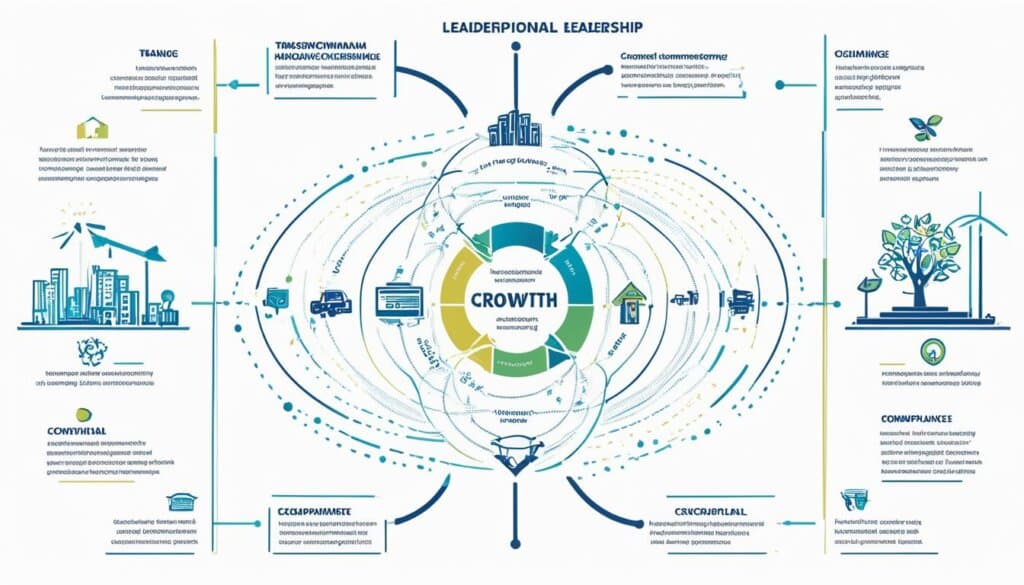Table of Contents
Transformational leadership is a leadership style that has gained prominence in recent years. It is a management philosophy that focuses on inspiring and motivating employees to create meaningful change within an organisation. This leadership style is particularly well-suited for today’s rapidly changing digital era, where organisations across industries are facing constant transformation.
The concept of transformational leadership was first introduced by James MacGregor Burns in the 1970s. It emphasises the importance of facilitating organisational collaboration and driving a vision forward. In contrast to transactional leadership, which focuses on exchanges and rewards, transformational leadership goes beyond these traditional approaches by inspiring employees to exceed expectations and work towards a shared vision.
Transformational leadership comprises four key components: individualised consideration, inspirational motivation, idealised influence, and intellectual stimulation. Successful transformational leaders have traits such as self-awareness, open-mindedness, adaptability, proactivity, and humility.
Transformational leadership is a powerful leadership style that can lead to organisational success and inspire change. It empowers employees to contribute their ideas and execute tasks more effectively, resulting in increased innovation, collaboration, and overall success.
The Origins and Development of Transformational Leadership
The concept of transformational leadership originated in the 1970s, introduced by James MacGregor Burns. Burns identified transformational leadership as an approach that focuses on creating significant change in individuals and organizations. The key aspect of this leadership style is the mutually beneficial relationship between leaders and followers, where they help each other advance to higher levels of morale and motivation.
Kevin Ford, an expert in organizational change and leadership development, further developed the concept of transformational leadership. He identified three effective leadership styles, namely tactical leadership, strategic leadership, and transformational leadership. While tactical and strategic leaders focus on problem-solving and future-oriented planning respectively, transformational leaders prioritize organizational collaboration to drive a shared vision forward. They are less concerned with making decisions or establishing strategic plans and more focused on facilitating collaboration and creating a sense of purpose within the organization.
In summary, transformational leadership originated from James MacGregor Burns in the 1970s and was further developed by Kevin Ford. It emphasizes creating significant change, promoting collaboration, and fostering a shared sense of purpose within organizations.
| Transformational Leadership | Tactical Leadership | Strategic Leadership | |
|---|---|---|---|
| Description | Focuses on creating significant change, inspiring collaboration, and establishing a shared vision within organizations. | Focuses on problem-solving and immediate task-oriented approaches to leadership. | Focuses on future-oriented planning and guiding organizations towards strategic goals. |
| Leadership Approach | Beyond decision-making and strategic planning, transformational leaders prioritize collaboration and creating a sense of purpose. | Uses directives, rewards, and exchanges to motivate employees to achieve specific goals and tasks. | Develops long-term strategies, analyzes market trends and future opportunities to guide the organization’s direction. |
| Employee Focus | Creates an engaged and motivated workforce, empowers employees through individualized consideration and intellectual stimulation. | Emphasizes meeting specific goals and tasks, rewards employees based on performance criteria. | Aligns the organization with a strategic direction, encourages employees to contribute towards achieving long-term objectives. |
| Outcome | Inspires innovation, collaboration, and organizational success by providing a sense of purpose and meaning to employees’ work. | Achieves predefined goals and tasks efficiently, ensuring adherence to established processes. | Guides the organization towards long-term success by identifying and capitalizing on strategic opportunities. |
In conclusion, transformational leadership stands apart from tactical and strategic leadership in its focus on collaboration, shared vision, and creating a sense of purpose. It empowers employees, inspires innovation, and achieves organizational success. Understanding the origins and development of transformational leadership provides valuable insights into its effectiveness in today’s rapidly changing business landscape.
Transformational Leadership vs. Transactional Leadership
Transformational leadership and transactional leadership are two distinct leadership styles that have been extensively researched. While some leaders may exhibit varying degrees of both styles, they have different approaches and outcomes.
Transactional leadership is based on a system of exchanges and rewards between the leader and employees. Employees are motivated through positive reinforcement and evaluated based on predetermined performance criteria. The focus is on meeting specific goals and tasks, without necessarily encouraging innovative thinking.
Transformational leadership, on the other hand, goes beyond exchanges and rewards. It inspires employees to work towards a shared vision and exceed expectations. This leadership style focuses on intrinsic motivation, providing a sense of purpose and meaning to the tasks at hand. Transformational leaders listen to employees’ concerns and tailor their management styles to accommodate individual needs. They articulate a unified vision, model ethical behavior, and challenge assumptions. They foster an environment that encourages creativity, risk-taking, and diverse perspectives, empowering employees to contribute their ideas and execute tasks more effectively.
Key Contrasts: Transformational Leadership vs. Transactional Leadership
| Aspect | Transformational Leadership | Transactional Leadership |
|---|---|---|
| Focus | Fostering intrinsic motivation, shared vision, and innovation. | Exchanging rewards for meeting specific goals and tasks. |
| Motivation | Inspiring employees through a sense of purpose and meaning. | Motivating employees through positive reinforcement. |
| Management Style | Adapts to individual needs, encourages creativity and risk-taking. | Establishes performance criteria, focuses on meeting goals. |
| Communication | Listens to concerns, articulates a unified vision. | Directs and evaluates employees based on performance criteria. |
Transformational leadership has been found to have a positive impact on employee motivation, engagement, and organizational success. The emphasis on fostering intrinsic motivation helps create a work environment that encourages creativity, innovation, and collaboration. On the other hand, transactional leadership can be effective in achieving specific goals and maintaining performance standards in organizations that require strict adherence to predefined tasks.
In sum, while transactional leadership focuses on exchanges and rewards, transformational leadership inspires employees to exceed expectations and work towards a shared vision. Both leadership styles have their advantages and may be appropriate in different organizational contexts. However, transformational leadership, with its emphasis on employee empowerment and intrinsic motivation, has been shown to drive higher levels of employee engagement and organizational performance.

Advantages and Disadvantages of Transformational Leadership
Transformational leadership offers several benefits to organizations. By inspiring employees to exceed expectations and work towards a shared vision, it creates an engaged and motivated workforce. This, in turn, leads to increased innovation, collaboration, and overall organizational success. Transformational leaders empower their employees by providing individualized consideration, expressing inspirational motivation, modeling ethical behavior, and stimulating intellectual engagement. By fostering a sense of purpose and meaning, this leadership style encourages greater commitment and effort from employees, ultimately driving productivity.
However, like any leadership style, there are also potential drawbacks to transformational leadership. The visionary and big-picture focus of transformational leaders may sometimes lack detailed directions, which can lead to confusion or inefficiency in task execution. If the leader’s vision is too ambitious or unrealistically high, employees may become overwhelmed or discouraged, hindering their performance. Additionally, not all employees may fully align with the leader’s vision, which can create resistance or a lack of buy-in, ultimately impeding progress.
Furthermore, maintaining high levels of enthusiasm and engagement requires ongoing communication and encouragement from the leader, which can be time-consuming. Transformational leaders must invest significant effort in building and nurturing relationships with their team members to sustain the desired results. However, with effective communication and ongoing support, the benefits of transformational leadership can outweigh these challenges, leading to an empowered and highly motivated workforce that drives lasting positive change within the organization.
FAQ
What is transformational leadership?
Transformational leadership is a leadership style that focuses on inspiring and motivating employees to create meaningful change within an organization. It emphasizes collaboration, a shared vision, and exceeding expectations.
Who introduced the concept of transformational leadership?
The concept of transformational leadership was first introduced by James MacGregor Burns in the 1970s. He identified it as a leadership approach that focuses on creating significant change in individuals and organizations.
How does transformational leadership differ from transactional leadership?
While transactional leadership is based on exchanges and rewards, transformational leadership goes beyond these traditional approaches. Transformational leaders inspire employees to work towards a shared vision and exceed expectations, focusing on intrinsic motivation and fostering a sense of purpose and meaning.
What are the advantages of transformational leadership?
Transformational leadership offers several advantages for organizations. It creates an engaged and motivated workforce, leading to increased innovation, collaboration, and organizational success. It empowers employees and fosters a sense of purpose and meaning, resulting in greater commitment and effort.
Are there any disadvantages to transformational leadership?
Yes, there can be potential disadvantages to transformational leadership. The visionary and big-picture focus of transformational leaders may sometimes lack detailed directions, leading to confusion or inefficiency. If the vision is too ambitious, employees may become overwhelmed. Additionally, not all employees may align with the leader’s vision, creating resistance or lack of buy-in.












